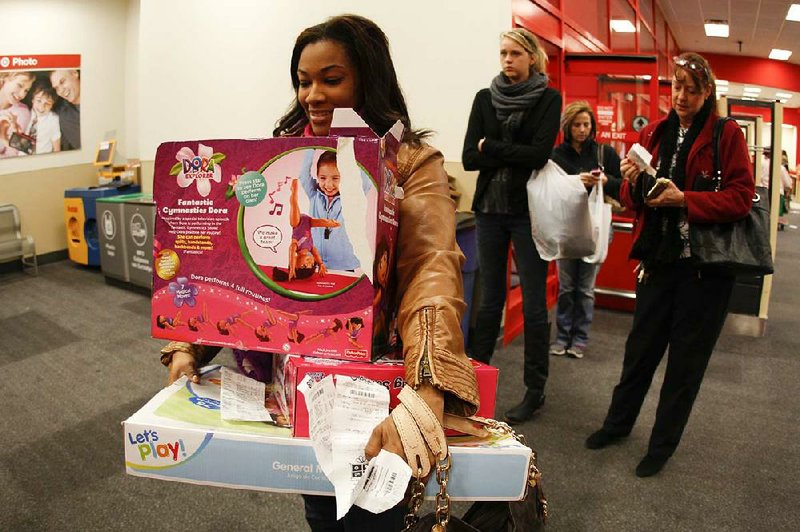WEST PALM BEACH, Fla. — Once the gifts are opened, if you are left staring at a scratchy sweater that’s a hideous shade of green or a weird kitchen gadget you don’t think you will ever use, you could be headed to a dreaded return line.
Or for purchases made online, boxing the item and shipping it back to the retailer.
Consider donating the item to a charity and saving yourself some stress. Before making a return, check the store’s policy on its website. Every retailer has a unique policy, and it could have changed.
Choosing the perfect gift is tough, and last year about 1 in 5 adults received an unwanted gift, according to the National Retail Federation and Consumer Reports National Research Center.
The basic rules: Return the item before the allowable time period expires, and have your receipt with you. Thoughtful gift givers make sure the gift receipt is included. If you can’t find the receipt, some retailers can search for it in their system.
If you think you might return an item, leave it in its original box. If it is encased in Styrofoam, don’t tamper with it.
If you don’t have the receipt, you might end up being refunded the lowest markdown price. If the store can’t be sure the item was purchased there, you will most likely be given zero.
Many retailers have tightened their return policies in the last few years, which is probably one reason there are not a lot of changes in return policies this year. The National Retail Federation reports that 83 percent of stores have kept their policies the same, 10 percent have loosened them, and 7 percent have made them stricter.
Don’t be offended if the store clerk wants to see your identification, especially if you have no receipt. Stores are trying to prevent fraudulent returns of stolen merchandise, returns using counterfeit receipts or returns of used or worn items. The industry will lose an estimated $8.9 billion to return fraud this year, with $2.9 billion at Christmas alone, according to the National Retail Federation’s 2012 Return Fraud Survey.
“Return fraud comes in a variety of forms and continues to present challenges for retailers trying to grapple with the sophisticated methods criminals are using to rip off retailers,” says NRF Vice President of Loss Prevention Rich Mellor. “Even more troubling is the fact that innocent consumers often suffer because companies have to look for ways to prevent and detect all types of crime and fraud in their stores, oftentimes resorting to shorter return windows and limitations on the types of products that can be returned.”
The NRF survey found that 97 percent of retailers polled say they have experienced the return of stolen merchandise in the last year, and 84 percent report that they have experienced the return of merchandise purchased on fraudulent or stolen credit or debit cards.
Wardrobing — the return of used, non-defective merchandise like special-occasion apparel and certain electronics — is a huge issue, with nearly 69 percent saying they have been victims of this activity within the last year. Additionally, 46 percent have found criminals using counterfeit receipts to return merchandise.
Employee return fraud or collusion with external sources is also a big problem for retailers: 81 percent report they’ve dealt with this issue in the past year.
RETURNS WITH EASE,
RESTOCKING FEES
Most stores have a general return policy for merchandise with a receipt that covers such goods as clothing and handbags, for example. They often have a list of merchandise subject to shorter time periods for returns. That usually includes electronics. Restocking fees may also apply.
For example, Wal-Mart has a 90-day return policy for most items. Most of the year, it has a 15-day return policy for computers, video game hardware, GPS units and similar items, and a 30-day policy for merchandise such as lawn mowers and generators.
However, for purchases made between Nov. 1 and Dec. 24 for goods with a return policy of 15 or 30 days, Wal-Mart has extended the return period by starting to count those days on Dec. 26. Items that have the usual 90-day return window must still be returned within 90 days of purchase.
JC Penney’s policy is one of the most liberal. “Happy returns, any item, anytime, anywhere, it’s that simple,” its website says. With a receipt, items purchased at JCP are eligible for exchange or refund of the purchase price on the original method of payment. But without a receipt, the item is eligible for exchange or refund at the current price, issued in the form of a gift card.
Kohl’s, too, has no deadline for returns and a policy similar to JCP. “Return any item, anytime, for any reason,” Kohl’s states on its website. With a receipt, you’ll get a full refund or even exchange. With a gift receipt, you’ll get an even merchandise credit. Without a receipt, you have a choice of a refund, an exchange or merchandise credit.
Nordstrom has a similar “return anything, any time” policy. But returns to Nordstrom Rack must be made within 30 days.
No matter how generous the return policies, most stores won’t accept return of a gift card. Of course, stores reserve the right to refuse a refund or exchange, and obviously won’t take back anything that’s used or damaged.
Shipping charges aren’t refundable either, unless the store made an error.
Sports Authority will not accept purchases made at its online store as returns at its brick-and-mortar stores.
Weekend, Pages 31 on 01/03/2013
